Characteristics
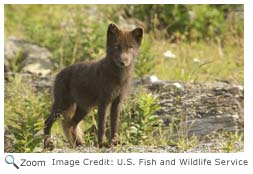 The arctic fox is dark gray to brown to bluish-brown in the summer. In the winter, its fur is white or creamy white. It has a long bushy tail, a short nose, and small curled back ears. It has short, stubby legs and thick fur. Its short legs and nose, thick fur, and small ears are adaptations that help it survive in cold climates. Because its legs are so short and its ears and nose are small, there is less of the fox exposed to the cold. The arctic fox is dark gray to brown to bluish-brown in the summer. In the winter, its fur is white or creamy white. It has a long bushy tail, a short nose, and small curled back ears. It has short, stubby legs and thick fur. Its short legs and nose, thick fur, and small ears are adaptations that help it survive in cold climates. Because its legs are so short and its ears and nose are small, there is less of the fox exposed to the cold.
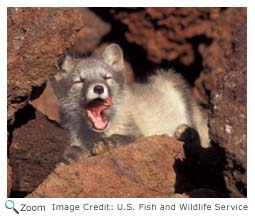 The arctic fox also has thick fur and hair on its paw pads that helps keep it warm. The fur on its paws also gives the fox traction so it doesn't slide on the ice! When the arctic fox is sleeping, it protects its nose from the cold by curling its bushy tail around its body. The arctic fox is about three feet long and weighs between five and fifteen pounds. Males are larger than females. The arctic fox also has thick fur and hair on its paw pads that helps keep it warm. The fur on its paws also gives the fox traction so it doesn't slide on the ice! When the arctic fox is sleeping, it protects its nose from the cold by curling its bushy tail around its body. The arctic fox is about three feet long and weighs between five and fifteen pounds. Males are larger than females.
Range
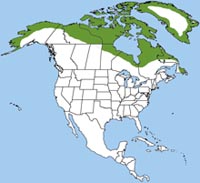 In North America, the arctic fox is found from western Alaska east through northern Canada and in Greenland.
It is also found in the arctic regions of Europe, Asia, and Iceland. In North America, the arctic fox is found from western Alaska east through northern Canada and in Greenland.
It is also found in the arctic regions of Europe, Asia, and Iceland.
Habitat
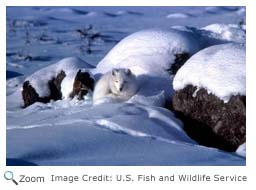 In the summer, the arctic fox lives in the tundra at the edge of forest. In the winter, it is found on ice floes where its white coat serves as camouflage. Its den is usually a burrow in a hillside or a bank. The burrow has more than one entrance. In the winter, the fox often makes its den in a snowbank! In the summer, the arctic fox lives in the tundra at the edge of forest. In the winter, it is found on ice floes where its white coat serves as camouflage. Its den is usually a burrow in a hillside or a bank. The burrow has more than one entrance. In the winter, the fox often makes its den in a snowbank! |
|
|
Diet
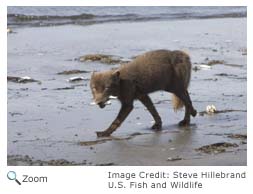 The arctic fox is an opportunistic eater. That means it eats just about whatever it comes across! It eats small mammals like lemmings, voles, ground squirrels, birds, insects, eggs, berries, and carrion. The arctic fox is an opportunistic eater. That means it eats just about whatever it comes across! It eats small mammals like lemmings, voles, ground squirrels, birds, insects, eggs, berries, and carrion.
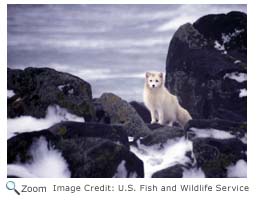 In fact, in the winter it often follows polar bears and wolves and eats their leftover kill. If food is really scarce, it eats the feces of other animals. In the summer, the arctic fox carries extra food to its den and stores it under rocks to eat later. The arctic fox sometimes even makes its own freezer by digging a hole in the permafrost and storing its food there! A major source of food for the arctic fox is the lemming. In fact, the arctic fox population often peaks every four years in a cycle that follows lemming population changes! In fact, in the winter it often follows polar bears and wolves and eats their leftover kill. If food is really scarce, it eats the feces of other animals. In the summer, the arctic fox carries extra food to its den and stores it under rocks to eat later. The arctic fox sometimes even makes its own freezer by digging a hole in the permafrost and storing its food there! A major source of food for the arctic fox is the lemming. In fact, the arctic fox population often peaks every four years in a cycle that follows lemming population changes!
Life Cycle
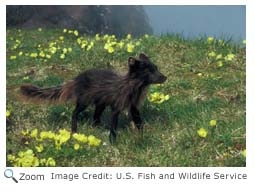 The arctic fox mates between February and June. The female builds a new den and gives birth to 6-12 dark furred kits. Both the female and the male take care of the young kits. The male guards the den and brings food to the den for the mother and the kits. The kits are weaned when they are between two to four weeks old. The arctic fox mates between February and June. The female builds a new den and gives birth to 6-12 dark furred kits. Both the female and the male take care of the young kits. The male guards the den and brings food to the den for the mother and the kits. The kits are weaned when they are between two to four weeks old.
Behavior
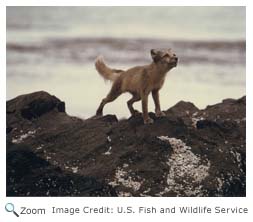 The arctic fox is nomadic, it moves from place to place looking for food. In the summer they live in family groups made up of a male, one or two females and the kits. The second female is a leftover kit from the year before, she doesn't breed. She helps care for the young.
|